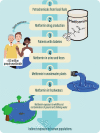Hypothesis: Metformin is a potential reproductive toxicant
- PMID: 36339411
- PMCID: PMC9627511
- DOI: 10.3389/fendo.2022.1000872
Hypothesis: Metformin is a potential reproductive toxicant
Abstract
Metformin is the first-line oral treatment for type 2 diabetes mellitus and is prescribed to more than 150 million people worldwide. Metformin's effect as a glucose-lowering drug is well documented but the precise mechanism of action is unknown. A recent finding of an association between paternal metformin treatment and increased numbers of genital birth defects in sons and a tendency towards a skewed secondary sex ratio with less male offspring prompted us to focus on other evidence of reproductive side effects of this drug. Metformin in humans is documented to reduce the circulating level of testosterone in both men and women. In experimental animal models, metformin exposure in utero induced sex-specific reproductive changes in adult rat male offspring with reduced fertility manifested as a 30% decrease in litter size and metformin exposure to fish, induced intersex documented in testicular tissue. Metformin is excreted unchanged into urine and feces and is present in wastewater and even in the effluent of wastewater treatment plants from where it spreads to rivers, lakes, and drinking water. It is documented to be present in numerous freshwater samples throughout the world - and even in drinking water. We here present the hypothesis that metformin needs to be considered a potential reproductive toxicant for humans, and probably also for wildlife. There is an urgent need for studies exploring the association between metformin exposure and reproductive outcomes in humans, experimental animals, and aquatic wildlife.
Keywords: development; endocrine disruptor; environment; metformin; reproductive toxicant; testosterone; wildlife.
Copyright © 2022 Tavlo, Skakkebæk, Mathiesen, Kristensen, Kjær, Andersson and Lindahl-Jacobsen.
Conflict of interest statement
The authors declare that the research was conducted in the absence of any commercial or financial relationships that could be construed as a potential conflict of interest.
Figures


References
-
- Davies MJ, D'Alessio DA, Fradkin J, Kernan WN, Mathieu C, Mingrone G, et al. . Management of hyperglycaemia in type 2 diabetes, 2018. a consensus report by the American diabetes association (ADA) and the European association for the study of diabetes (EASD). Diabetologia (2018) 61(12):2461–98. doi: 10.1007/s00125-018-4729-5 - DOI - PubMed
-
- ClinCalc DrugStats database. Available at: https://clincalc.com/DrugStats/About.aspx.
Publication types
MeSH terms
Substances
LinkOut - more resources
Full Text Sources
Medical

